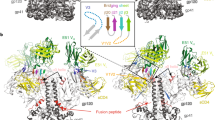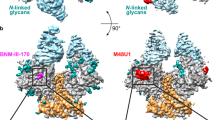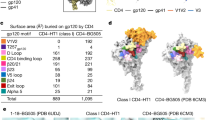Abstract
The entry of human immunodeficiency virus (HIV) into cells requires the sequential interaction of the viral exterior envelope glycoprotein, gp120, with the CD4 glycoprotein and a chemokine receptor on the cell surface. These interactions initiate a fusion of the viral and cellular membranes. Although gpl20 can elicit virus-neutralizing antibodies, HIV eludes the immune system. We have solved the X-ray crystal structure at 2.5 Å resolution of an HIV-1 gp120 core complexed with a two-domain fragment of human CD4 and an antigen-binding fragment of a neutralizing antibody that blocks chemokine-receptor binding. The structure reveals a cavity-laden CD4–gp120 interface, a conserved binding site for the chemokine receptor, evidence for a conformational change upon CD4 binding, the nature of a CD4-induced antibody epitope, and specific mechanisms for immune evasion. Our results provide a framework for understanding the complex biology of HIV entry into cells and should guide efforts to intervene.
This is a preview of subscription content, access via your institution
Access options
Subscribe to this journal
Receive 51 print issues and online access
$199.00 per year
only $3.90 per issue
Buy this article
- Purchase on Springer Link
- Instant access to full article PDF
Prices may be subject to local taxes which are calculated during checkout





Similar content being viewed by others
References
Barre-Sinoussi, F. et al. Isolation of a T-lymphotropic retrovirus from a patient at risk for acquired immunodeficiency syndrome (AIDS). Science 220, 868–871 (1983).
Gallo, R. C. et al. Frequent detection and isolation of cytopathic retroviruses (HTLV-III) from patients with AIDS and at risk for AIDS. Science 224, 500–503 (1984).
Kowalski, M. L. et al. Functional regions of the envelope glycoprotein of human immunodeficiency virus type 1. Science 237, 1351–1355 (1987).
Lu, M., Blackow, S. & Kim, P. Atrimeric structural domain of the HIV-1 transmembrane glycoprotein. Nature Struct. Biol. 2, 1075–1082 (1995).
Starcich, B. R. et al. Identification and characterization of conserved and variable regions of the envelope gene HTLV-III/LAV, the retrovirus of AIDS. Cell 45, 637–648 (1986).
Leonard, C. K. et al. Assignment of intrachain disulfide bonds and characterization of potential glycosylation sites of the type 1 recombinant immunodeficiency virus envelope glycoprotein (gp120) expressed in Chinese hamster ovary cell. J. Biol. Chem. 265, 10373–10382 (1990).
Profy, A. T. et al. Epitopes recognized by the neutralizing antibodies of an HIV-1-infected individual. J. Immunol. 144, 4641–4647 (1990).
Ryu, S.-E. et al. Crystal structure of an HIV-binding recombinant fragment of human CD4. Nature 348, 419–426 (1990).
Wang, J. H. et al. Atomic structure of a fragment of human CD4 containing two immunoglobulin-like domains. Nature 348, 411–418 (1990).
Wu, H., Kwong, P. D. & Hendrickson, W. A. Dimeric association and segmental variability in the structure of human CD4. Nature 387, 527–530 (1997).
Moebius, U., Clayton, L., Abraham, S., Harrison, S. & Reinhertz, E. The human immunodeficiency virus gp120 binding site of CD4: Delineation by quantitative equilibrium and kinetic binding studies of mutants in conjunction with a high-resolution CD4 atomic structure. J. Exp. Med. 176, 507–517 (1992).
Sweet, R. W., Truneh, A. & Hendrickson, W. A. CD4: its structure, role in immune function and AIDS pathogenesis, and potential as a pharmacologicla target. Curr. Opin. Biotech. 2, 622–633 (1991).
Olshevsky, U. et al. Identification of individual HIV-1 gp120 amino acids important for CD4 receptor binding. J. Virol. 64((1990)).
Cordonnier, A., Montagnier, L. & Emerman, M. Single amino-acid changes in HIV envelope affect viral tropism and receptor binding. Nature 340, 571–574 (1989).
Moore, J. P. Coreceptors: implications for HIV pathogenesis and therapy. Science 276, 51–52 (1997).
Feng, F., Broder, C. C., Kennedy, P. E. & Berger, E. A. HIV-1-entry cofactor: functional cDNA cloning of a seven-transmembrane, G protein-coupled receptor. Science 272, 872–877 (1996).
Speck, R. F. et al. Selective employment of chemokine receptors as human immunodeficiency virus type 1 coreceptors determined by individual amino acids in the envelope V3 loop. J. Virol. 71, 7136–7139 (1997).
Thali, M. et al. Characterization of conserved human immunodeficiency virus type 1 (HIV-1) gp120 neutralization epitopes exposed upon gp120-CD4 binding. J. Virol. 67, 3978–3988 (1993).
Sattentau, Q. J., Moore, J. P., Vignaux, F., Traincard, F. & Poignard, P. Conformational changes induced in the envelope glycoproteins of human and simian immunodeficiency virus by soluble receptor binding. J. Virol. 64, 7383–7383 (1993).
Wu, L. et al. CD4-induced interaction of primary HIV-1 gp120 glycoproteins with the chemokine receptor CCR5. Nature 384, 179–183 (1996).
Moore, J. P., McKeating, J. A., Weiss, R. A. & Sattentau, Q. J. Dissociation of gp120 from HIV-1 virions induced by soluble CD4. Science 250, 1139–1142 (1990).
Bullough, P. A., Hughson, F. M., Skehel, J. J. & Wiley, D. C. Structure of influenza haemagglutinin at the pH of membrane fusion. Nature 371, 37–43 (1994).
Fass, D. et al. Structure of a murine leukemia virus receptor-binding glycoprotein at 2.0 Ångström resolution. Science 277, 1662–1666 (1997).
Wyatt, R. et al. The antigenic structure of the HIV gp120 envelope glycoprotein. Nature 393, 705–711 (1998).
Kwong, P. D. et al. Quantitative probability analysis and variational crystallization of gp120, the exterior envelope glycoprotein of the human immunodeficiency virus type 1 (HIV-1). J. Biol. Chem. (submitted).
Binley, J. M. et al. Analysis of the interaction of antibodies with a conserved, enzymatically deglycosylated core of the HIV-1 gp120 envelope glycoprotein. AIDS Res. Hum. Retrovir. 14, 191–198 (1997).
Leesong, M., Hederson, B. S., Gillig, J. R., Schwab, J. M. & Smith, J. L. Structure of a dehydratase-isomerase from the bacterial pathway for biosynthesis of unsaturated fatty acids: two catalytic activities in one active site. Structure 4, 253–264 (1996).
Cedergren-Zeppezauer, E. S., Larsson, G., Nyman, P. O., Dauter, Z. & Wilson, K. S. Crystal structure of a dUTPase. Nature 355, 740–743 (1992).
Ryu, S.-E., Truneh, A., Sweet, R. W. & Hendrickson, W. A. Structures of an HIV and MHC binding fragment from human CD4 as refined in two crystal lattices. Structure 2, 59–74 (1994).
Rizzuto, C. et al. Aconserved HIV gp120 glycoprotein structure involved in chemokine receptor binding. Science (in the press).
Dragic, T. et al. Amino-terminal substitutions in the CCR5 coreceptor impair gp120 binding and human immunodeficiency type 1 entry. J. Virol. 72, 279–285 (1998).
Farzan, M. et al. Atryosine-rich region in the N-terminus of CCR5 is important for human immunodeficiency virus type 1 entry and mediates an association between gp120 and CCR5. J. Virol. 72, 1160–1164 (1998).
Wyatt, R. et al. Analysis of the interaction of the human immunodeficiency virus type 1 gp120 envelope glycoprotein with the gp41 transmembrane glycoprotein. J. Virol. 71, 9722–9731 (1997).
Helseth, E., Olshevsky, U., Furman, C. & Sodroski, J. Human immunodeficiency virus type 1 gp120 envelope glycoprotein regions important for association with the gp41 transmembrane glycoprotein. J. Virol. 65, 2119–2123 (1991).
Wilson, I. A., Skehel, J. J. & Wiley, D. C. Structure of the haemagglutinin membrane glycoprotein of influenza virus at 3 Å resolution. Nature 289, 366–373 (1981).
Wyatt, R. et al. Involvement of the V1/V2 variable loop structure in the exposure of human immunodeficiency virus type 1 gp120 epitopes induced by receptor binding. J. Virol. 69, 5723–5733 (1995).
Rost, B., Sander, C. & Schneider, R. PHD — an automated mail server for protein secondary structure prediction. Comput. Appl. Biosci. 10, 53–60 (1994).
Wyatt, R. et al. Functional and immunologic characterization of human immunodeficiency virus type 1 envelope glycoproteins containing deletions of the major variable regions. J. Virol. 67, 4557–4565 (1993).
Wu, H. et al. Kinetic and structural analysis of mutant CD4 receptors that are defective in HIV gp120 binding. Proc. Natl Acad. Sci. USA 93, 15030–15035 (1996).
Chan, D. C., Fass, D., Berger, J. M. & Kim, P. S. Core structure of gp41 from the HIV envelope glycoprotein. Cell 89, 263–273 (1997).
Weissenhorn, W., Dessen, A., Harrison, S. C., Skehel, J. J. & Wiley, D. C. Atomic structure of the ectodomain from HIV-1 gp41. Nature 387, 426–430 (1997).
Dumonceaux, J. et al. Spontaneous mutations in the env gene of the human immunodeficiency virus type 1 NDK isolate are associated with a CD4-independent entry phenotype. J. Virol. 72, 519–519 (1998).
Moir, S., Perreault, J. & Poulin, L. Postbinding events mediated by human immunodeficiency virus type 1 are sensitive to modifications in the D4-transmembrane linked region of CD4. J. Virol. 70, 8019–8028 (1996).
Kohlstaadt, L. A., Wang, J., Friedman, J. M., Rice, P. A. & Steitz, T. A. Crystal structure at 3.5 Å resolution of HIV-1 reverse transcriptase complexed with an inhibitor. Science 256, 1783–1790 (1992).
Otwinowski, Z. & Minor, W. Processing of X-ray diffraction data collected in oscillation mode. Meth. Enymol. 276, 307–326 (1997).
Brunger, A. T. XPLOR Version 3.1 manual (Yale University, New Haven, (1993)).
Jones, T. A., Zou, J. Y., Cowan, S. W. & Kjeldgaard, M. Improved methods for building protein models in electron density maps and the location of errors in these models. Acta Crystallogr. A 47, 110–119 (1991).
Zhu, X. et al. Structural analysis of substrate binding by the molecular chaperone DnaK. Science 272, 1606–1614 (1996).
Carson, M. Ribbons 2.0. J. Appl. Crystallogr. 24, 958–961 (1991).
Nicholls, A., Sharp, K. A. & Honig, B. Protein folding and association: insight from the interfacial and thermodynamic properties of hydrocarbons. Proteins Struct. Funct. Genet. 11, 281–296 (1991).
Acknowledgements
We thank M. Doyle for microcalorimetry results, C. Kokolis and the SSCC group at SmithKline Beecham for assistance with gp120 proteins, C. Lusty for suggestions on crosslinking, C.Ogata for beamline assistance, A.-S. Yang for automated structural alignment, and past and present members of W.A.H.'s group, especially D. Fremont for help with programs, E. Martinez-Hackert for help with figures, L. Shapiro for discussion, J. Williams for sequence alignments, and H. Wu for analysis of CD4 movement. Beamline X4A at the National Synchrotron Light Source, a Department of Energy facility, is supported by the Howard Hughes Medical Institute. This work was made possible by gifts from the late William McCarty-Cooper, from the G. Harold and Leila Y. Mathers Foundation, from the Friends 10, and from Douglas and Judi Krupp. Support was provided by the Aaron Diamond Foundation, the American Foundation for AIDS Research, the Howard Hughes Medical Institute, and the NIH.
Author information
Authors and Affiliations
Corresponding author
Rights and permissions
About this article
Cite this article
Kwong, P., Wyatt, R., Robinson, J. et al. Structure of an HIV gp120 envelope glycoprotein in complex with the CD4 receptor and a neutralizing human antibody. Nature 393, 648–659 (1998). https://doi.org/10.1038/31405
Received:
Accepted:
Issue Date:
DOI: https://doi.org/10.1038/31405
This article is cited by
-
gp120-derived amyloidogenic peptides form amyloid fibrils that increase HIV-1 infectivity
Cellular & Molecular Immunology (2024)
-
Absolute quantitation of binding antibodies from clinical samples
npj Vaccines (2024)
-
Inactivation of cell-free HIV-1 by designing potent peptides based on mutations in the CD4 binding site
Medical & Biological Engineering & Computing (2024)
-
HIV-1 Env trimers asymmetrically engage CD4 receptors in membranes
Nature (2023)
-
Facile hermetic TEM grid preparation for molecular imaging of hydrated biological samples at room temperature
Nature Communications (2023)
Comments
By submitting a comment you agree to abide by our Terms and Community Guidelines. If you find something abusive or that does not comply with our terms or guidelines please flag it as inappropriate.



